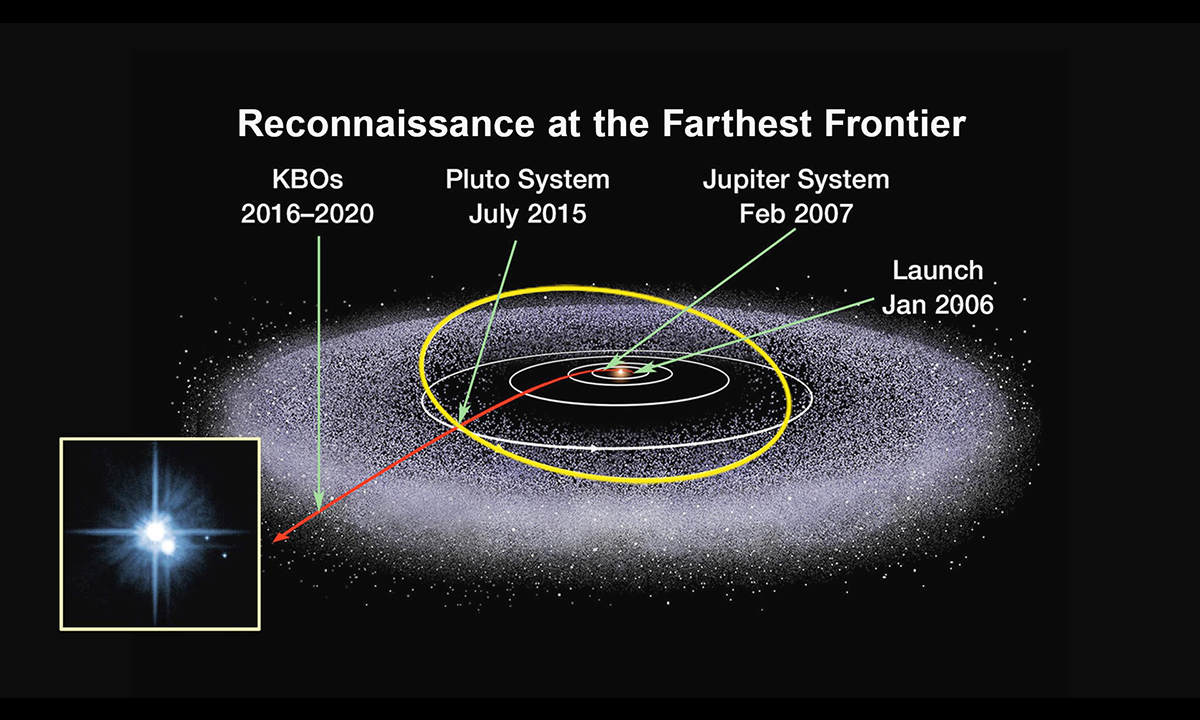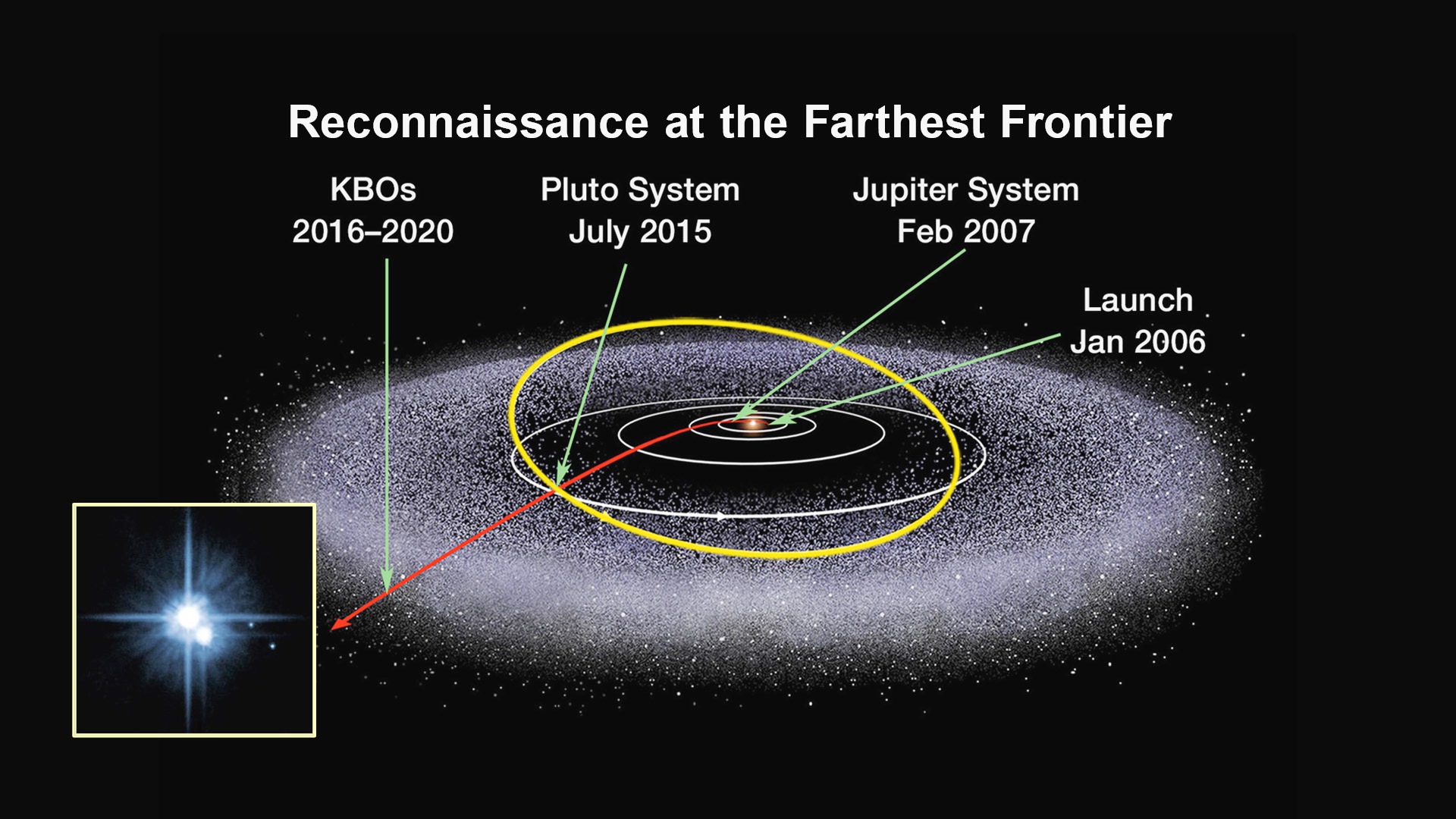Kuiper Belt: In Depth

| Credit | NASA |
|---|---|
| Language |
|
The Kuiper Belt is a disc-shaped region beyond Neptune that extends from about 30 to 55 astronomical units (compared to Earth which is one astronomical unit, or AU, from the sun). This distant region is probably populated with hundreds of thousands of icy bodies larger than 100 km (62 miles) across and an estimated trillion or more comets.
Dwarf planet Pluto may be the best known of the larger objects in the Kuiper Belt. Comets from the Kuiper Belt take less than 200 years to orbit the sun and travel approximately in the plane in which most of the planets orbit the sun. Objects in the Kuiper Belt are presumed to be remnants from the formation of the solar system about 4.6 billion years ago.
The first of these strange bodies, which astronomers call Kuiper Belt Objects (KBOs), came to light in 1992, discovered by Dave Jewitt and Jane Luu -- a pair of scientists who didn't believe the outer solar system was empty. Beginning in 1987 they had doggedly scanned the heavens in search of dim objects beyond Neptune. It took five years, looking off-and-on through the University of Hawaii's 2.2 m telescope, but they finally found what they were after: a reddish-colored speck 44 AU from the Sun -- even more distant than Pluto! Jewitt (University of Hawaii) and Luu (UC Berkeley) wanted to name their find "Smiley," but it has since been cataloged as "1992 QB1."
That discovery marked our first glimpse of the long-sought Kuiper Belt, named after Gerard Kuiper who, in 1951, proposed that a belt of icy bodies might lay beyond Neptune. It was the only way, he figured, to solve a baffling mystery about comets: Some comets loop through the solar system on periodic orbits of a half-dozen years or so. They encounter the Sun so often that they quickly evaporate -- vanishing in only a few hundred thousand years. Astronomers call them "short-period comets," although "short-lived" is more to the point. Short-period comets evaporate so quickly compared to the age of the solar system that we shouldn't see any, yet astronomers routinely track dozens of them. It was a real puzzle.
Kuiper's solution was a population of dark comets circling the Sun in the realm of Pluto -- leftovers from the dawn of our solar system when planetesimals were coalescing to make planets. The ones beyond Neptune, Kuiper speculated, never stuck together, remaining instead primitive and individual. Nowadays they occasionally fall toward the Sun and become short-period comets.
Because KBOs are so distant, their sizes are difficult to measure. The calculated diameter of a KBO depends on assumptions about how reflective the object's surface is. With infrared observations by the Spitzer Space Telescope, most of the largest KBOs have known sizes.
One of the most unusual KBOs is Haumea, which is a part of a collisional family orbiting the sun. The parent body, Haumea, apparently collided with another object that was roughly half its size. The impact blasted large icy chunks away and sent Haumea reeling, causing it to spin end-over-end every four hours. It spins so fast that it has pulled itself into the shape of a squashed American football. Haumea and two small moons -- Hi'iaka and Namaka -- make up the family.
In March 2004, a team of astronomers announced the discovery of a planet-like transneptunian object orbiting the sun at an extreme distance, in one of the coldest known regions of our solar system. The object (2003VB12), since named Sedna for an Inuit goddess who lives at the bottom of the frigid Arctic ocean, approaches the sun only briefly during its 10,500-year solar orbit. It never enters the Kuiper Belt, whose outer boundary region lies at about 55 AU -- instead, Sedna travels in a long, elliptical orbit between 76 and nearly 1,000 AU from the sun. Since Sedna's orbit takes it to such an extreme distance, its discoverers have suggested that it is the first observed body belonging to the inner Oort Cloud.
In July 2005, a team of scientists announced the discovery of a KBO that was initially thought to be about 10 percent larger than Pluto. The object, temporarily designated 2003UB313 and later named Eris, orbits the sun about once every 560 years, its distance varying from about 38 to 98 AU. (For comparison, Pluto travels from 29 to 49 AU in its solar orbit.) Eris has a small moon named Dysnomia. More recent measurements show it to be slightly smaller than Pluto.
The discovery of Eris -- orbiting the sun and similar in size to Pluto (which was then designated the ninth planet) -- forced astronomers to consider whether Eris should be classified as the tenth planet. Instead, in 2006, the International Astronomical Union created a new class of objects called dwarf planets, and placed Pluto, Eris and the asteroid Ceres in this category.
In 2015, NASA's New Horizons spacecraft flew past Pluto, making the first up-close exploration of a Kuiper Belt Object. The spacecraft is continuing deeper into this region of icy debris and may be able to explore at least one more object.
How the Kuiper Belt Got Its Names
The region is named for the astronomer who predicted its existence -- Gerard Kuiper. It is sometimes called the Edgeworth-Kuiper Belt, recognizing the independent and earlier discussion by Kenneth Edgeworth. Objects discovered in the Kuiper Belt get their names from diverse mythologies. Eris is named for the Greek goddess of discord and strife. Haumea is named for a Hawaiian goddess of fertility and childbirth. Comets from both regions are generally named for the person who discovered them.
Significant Dates
- 1943: Astronomer Kenneth Edgeworth suggests that a reservoir of comets and larger bodies resides beyond the planets.
- 1951: Astronomer Gerard Kuiper predicts the existence of a belt of icy objects just beyond the orbit of Neptune.
- 1992: After five years of searching, astronomers David Jewitt and Jane Luu discover the first KBO, 1992QB1.
- 2002: Scientists using the 48-inch Oschin telescope at Palomar Observatory find Quaoar, the first large KBO hundreds of kilometers in diameter. This object was photographed in 1980, but was not noticed in those images.
- 2004: Astronomers using the 48-inch Oschin telescope announce the discovery of Sedna (2003VB12).
- 2005:Astronomers announce the discovery of 2003UB313. This object, later named Eris, is slightly larger than Pluto.
- 2008: The Kuiper Belt object provisionally known as 2005FY9 ("Easterbunny") is recognized in July as a dwarf planet and named Makemake (pronounced MAHkeh-MAHkeh) after the Polynesian (Rapa Nui) creation god. In September, 2003EL61 ("Santa") was designated a dwarf planet and given the name Haumea after the Hawaiian goddess of fertility and childbirth.

